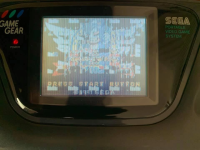T-Squared
Veteran Member
I am working on restoring my Game Gear, and I seem to have zapped its SRAM by accident.
The system began giving me badly-placed tile images, and when I clipped out its video SRAM, it gave me gibberish. No biggie. Floating pads with no inputs? That's expected.
However, when I bought some new SRAM to replace it, it was as if the chip was never soldered on. It gave me the same gibberish as before.
I've read about RAM access time from YouTube user JoulesperCoulomb, with how he's repaired ZX Spectrum systems before.
The old chip's maximum access time was around the neighborhood of 150-100ns, and the new chip's maximum access time was 55ns.
Is there a limit to the maximum access ability of older systems, or did something permanently malfunction on my Game Gear?
I'm sorry if this isn't appropriate for this subforum, but it does have to do with memory, which is relevant to computer hardware.
The system began giving me badly-placed tile images, and when I clipped out its video SRAM, it gave me gibberish. No biggie. Floating pads with no inputs? That's expected.
However, when I bought some new SRAM to replace it, it was as if the chip was never soldered on. It gave me the same gibberish as before.
I've read about RAM access time from YouTube user JoulesperCoulomb, with how he's repaired ZX Spectrum systems before.
The old chip's maximum access time was around the neighborhood of 150-100ns, and the new chip's maximum access time was 55ns.
Is there a limit to the maximum access ability of older systems, or did something permanently malfunction on my Game Gear?
I'm sorry if this isn't appropriate for this subforum, but it does have to do with memory, which is relevant to computer hardware.

